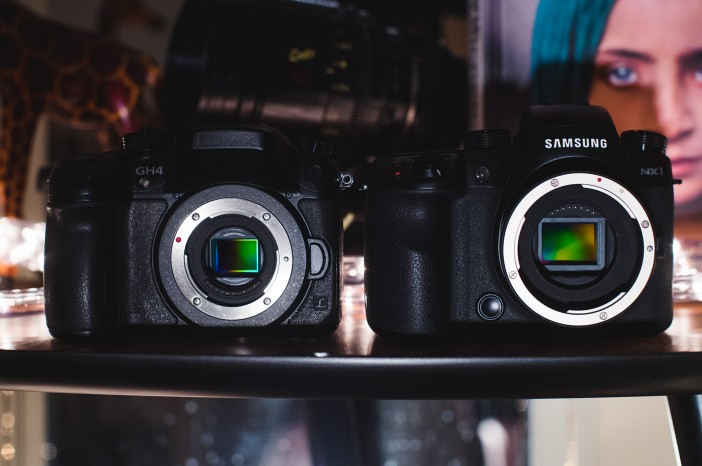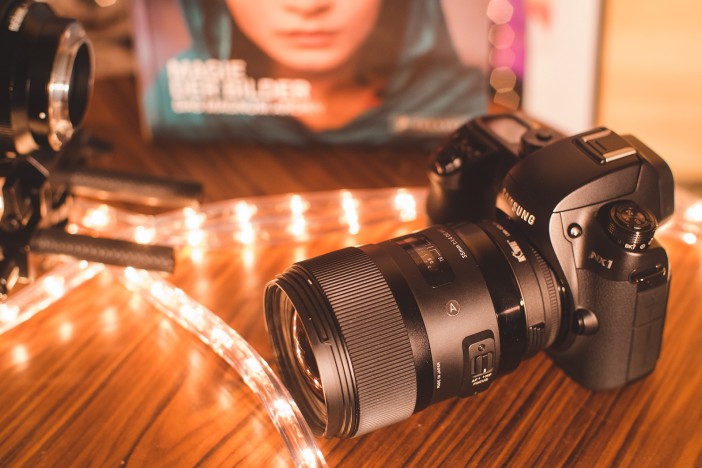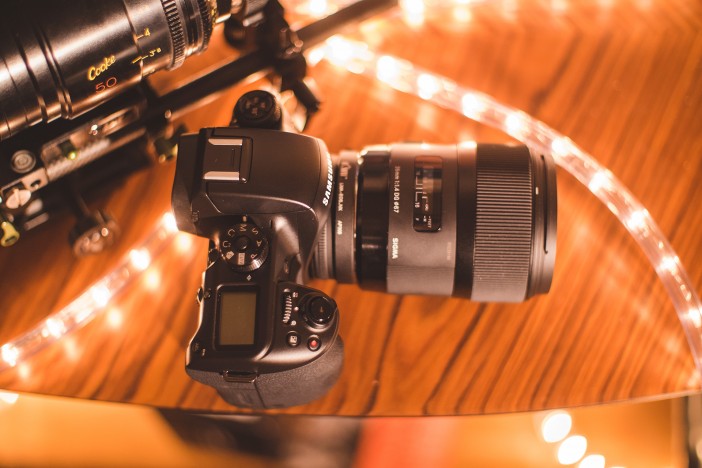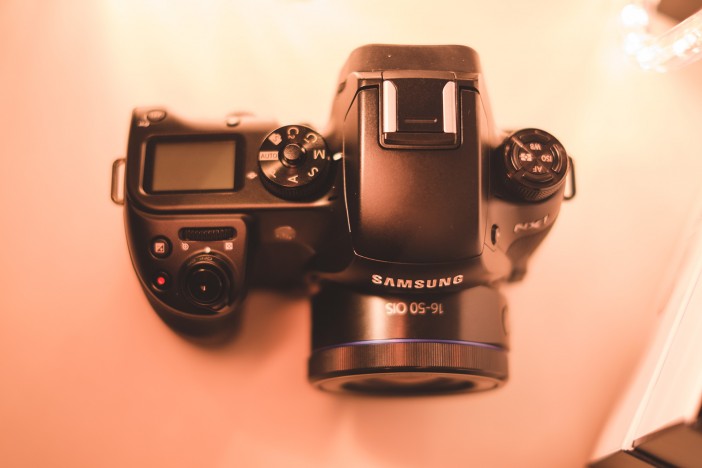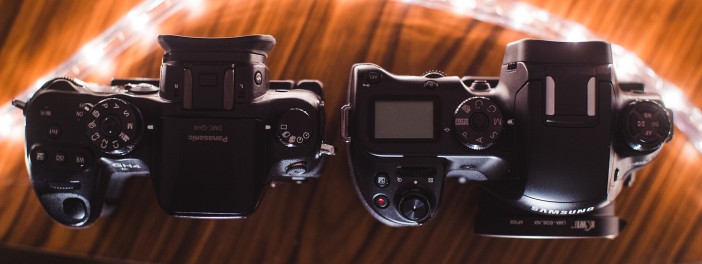As always, be sure to download the 4K version from Vimeo here to get any idea at all about the full image quality!
Not a Vimeo Plus member? Download one of my original NX1 4K clips here. This is H.265 converted to ProRes LT.
The NX1 costs $1499 body only or $1699 with the 16-50mm power zoom OIS lens.
The NX1 is a 4K camera out of the box but make no mistake, it is really a 6K camera. When the NX1 was being developed in Samsung’s lab, the sensor output ran at 6.5K raw at 240fps. Although the feature was only for debugging and not destined for consumers, this should give you an idea of the kind of hardware advances they have made with this camera and the new manufacturing techniques they are employing to get there.
The camera has a CPU with 5 cores (general purpose), 240fps object tracking. 4K video, H.265 and 1080/120fps. Further dedicated hardware cores handle various computational tasks rather than them being done in software.
With this camera Samsung are starting to put their boot into the camera industry in a big way.
And it shows in the images.
At the moment there are just three affordable interchangeable lens cameras that record 4K internally. First we had the Panasonic GH4 and Blackmagic Production Camera. Now we have the Samsung NX1.
Let’s start with that sensor. It is basically a portable, power efficient version of the CMOS in the 6K RED Dragon. It can do the 6.5K raw readout thanks to a copper process on the sensor that reduces resistance and therefore heat by 70%. It is the industry’s first 28MP APS-C sensor for stills cameras (Super 35mm in cinema terms) and the first backside illuminated APS-C sensor. You can read a great interview over at Imaging Resource with Samsung about this here.
At low ISOs I prefer the 4K video from the NX1 to both the GH4 and Blackmagic. Yet file sizes are smaller. This is down to H.265, the High Efficiency Video Codec which is H.264’s successor, and will one day be the most common video codec in the world. Right now it’s a bit of a pain. We’ll come to the workflow in a moment. However with file sizes 1/10th the size of the Blackmagic Production Camera’s 4K ProRes it shows once again the power Samsung have put inside this camera to crunch the numbers. Even the Mac Pro cannot encode H.265 anywhere near real-time without dedicated hardware to do the job.
Another notable aspect of the NX1 is it is the first 4K camera to run from Tizen, the Linux based operating system for smart devices, of which Samsung is a steering group member along with Intel. This operating system is incredibly responsive on the NX1 thanks to an extremely powerful processor. It uses a unique design that blends the programmability of a general purpose CPU with that of hardware dedicated for a certain task. It makes the electronics inside a 5D Mark III seem like they date back to the 70’s by comparison.
This camera can machine-gun off a continuous burst of 28MP raw at 15fps. That’s faster than Canon can do just 18MP at 14fps, alas they want $6000 for that kind of performance with the 1D X. The Samsung solution is $1599. By further comparison Sony’s latest 36MP sensor in the Nikon D810 only does 5fps.
No camera is perfect though and we’ll run through some of the weaker points in a moment. Although the AF system in the camera is absolutely cutting edge and unique on the market, it does become unreliable in low contrast conditions and in very dim light. Lenses can be an issue too, since Samsung simply do not have the kind of lens range to compete with Canon for stills with AF or for sports yet. But clearly Samsung has begun some kind of march to superiority with this camera. And one day I have no doubt they will reach the top.
Meanwhile Sony’s ascendancy to the top of the CMOS sensor industry has been pretty much unequalled until now, but Samsung look to be able to take that kind of leading step. The plan is to apply the same technology to other imaging devices “soon” along wide ISOCELL sensors in smartphones. The NX1 does not actually have an ISOCELL sensor but the design mimics one, minimising crosstalk between pixels. Make no mistake… Samsung are now capable of making some of the finest image sensors in the world.
H.265 – marketing, or a real advantage?
The H.265 codec on the Pro setting (highest) is 70Mbit/s 4:2:0. I confirmed this by looking at the file metadata. You benefit from a 30% space saving of 70Mbit compared to 100Mbit on the GH4, and that was already a very small file size for 4K. Here’s a full 4K frame, click to enlarge then drag to desktop for the 4K version…
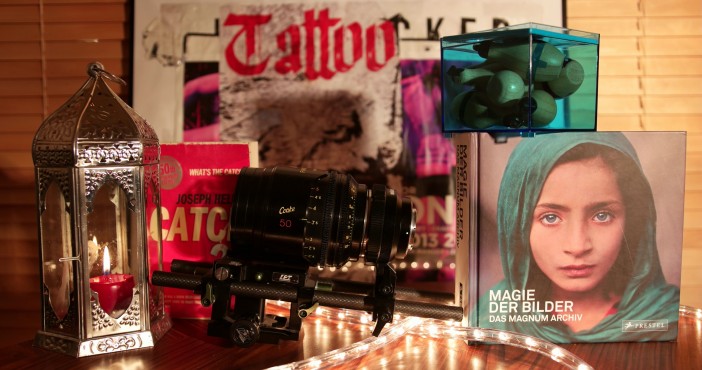
Image quality is absolutely astounding in good light on this camera. Beautiful colour and RED-like feel to detail – neither too sharp or too soft, and plenty of it. The codec is able to hold onto that very well however I am not sure how much of that is down to the clearly superb sensor in the NX1 or the new codec. Would this camera have been just as good with H.264 at 100Mbit like the GH4?
I have my doubts about the codec because of the way it handles low contrast areas and high ISOs. It smudges away fine grain and introduces macro blocking in some cases, whilst H.264 in the GH4 doesn’t. The NX1 is not a great ISO 3200 camera for video but then neither is the GH4 and at ISO 1600 the NX1 is cleaner looking. Over well lit detailed areas of the image, the NX1 is super good in every way.
Although the NX1 gives you the smallest 4K files on the market today yet I can’t help feeling that Samsung have taken a marketing led decision to put H.265-only in the NX1. Without a more compatible codec like H.264 to fall back on it’s a decision that goes against the interests of the vast majority of their users. HEVC H.265 is a complex codec and transcoding is a very lengthy process especially in the supplied Samsung Movie Converter, which feels unfinished.
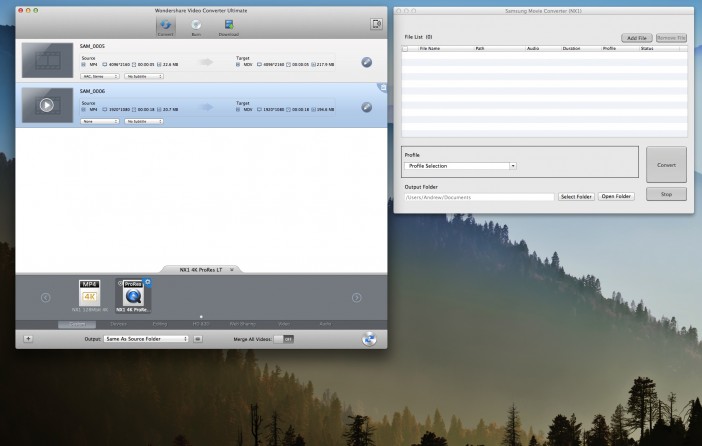
My workflow
Findings on the workflow front so far are intriguing. What app you use to convert the files is critical to the quality and delivery time of the results.
A tiny 3 second clip took 40 seconds to convert in the Samsung app but less than half the time in an app called Wondershare Video Converter Ultimate.
The latter also has a better GUI and more options, including ProRes in various flavours, not just H.264. If you don’t want to buy a lifetime license for Wondershare a 1 year license costs just $39.99. It’s worth it.
In Samsung’s app a 7 second HEVC clip of 60MB grew to a 140MB H.264 file. That’s 200Mbit/s on the highest setting. Not too shabby but the problem is it takes AGES to transcode and the resulting file is taxing on the CPU to edit. The same 60MB HEVC clip becomes 260MB in Wondershare using ProRes LT – BUT the larger file is worth having because it is quicker to transcode and better for Premiere to deal with ProRes, less CPU overhead when editing 4K.
On default settings Wondershare crushes the hell out of the blacks, so you must put -12 in the contrast setting for the clip and then click Apply To All Clips before transcoding. It is vital you do this unless you want to lose nearly 2 stops of detail in the blacks.
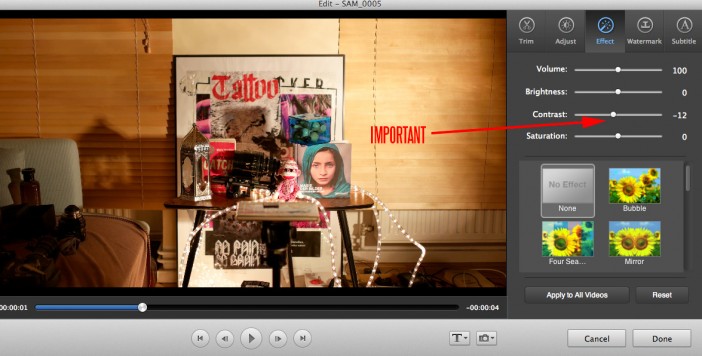
There’s a marked quality and speed difference between Wondershare and the free app I found that accepts H.265 files – Handbrake. I cannot recommend Handbrake, it is cripplingly slow and it is awkward to manage a batch queue.
The only other thing to look out for is that Wondershare does put the tint a bit more towards magenta, which subtly alters skintones. Also warm oranges look a tiny bit duller with it. However these differences are so small, they’re trivial to overcome in the grade. I am using Film Convert Pro 2.1 and the Arri Alexa DCIP3 profile is a nice fit for the Standard picture profile on the NX1 with contrast -6 and sharpness -10.
I have disabled SmartRange+ in the camera menus for movies because it is some kind of auto-ISO adjustment which dynamically brightens shadows or darkens highlights on the fly. Not nice.
Unfortunately the is no way to get a really flat image out of the NX1 (certainly not S-LOG flat) but the end results do grade well regardless. A lot of people have this misconception that causes them to overrate a flat image profile and overrate things like peaking. Just because they are professional video features doesn’t mean to say you always need them. If colour is great straight out of the camera and you can tweak it in post, that is still a lot of freedom and you can concentrate on just shooting and do you grading with lights. Afterwards if you want to raise the blacks just lift the bottom of your RGB master curve. Easy!
My fear is that consumers without researching workflows or without the technical knowledge to deal with the NX1’s codec are in for a total nightmare, because they will likely spend ages trying without success to play or edit the H.265 files, before finally finding that tiny page in the tiny quickstart guide which unclearly points them towards i-Launcher, which does that protracted install just to give you a download link for a p*** poor conversion app. Once again Samsung need to up their game on the software side.
If you are someone who only watches movies from your camera via HDMI to your TV then it will be ok but if you just want to quickly view & edit clips on your PC then to get the right software and workflow takes technical knowledge and research.
Low light performance and image quality vs the Panasonic GH4
What kind of ‘film stock’ is the NX1? Again I’d draw a comparison to RED’s 4K or 6K, it has a modern feel like the Canon C300, punchy and contrasty. Less like Super 16mm and quite different to the more restrained looking GH4.
This new Samsung sensor is a massive step forward for them, indeed the whole industry. In good light this sensor produces really top notch video. Beautiful Canon / Nikon-like colour but with the resolving power of the best 4K cinema cameras. Great dynamic range too, although perhaps 1 stop less in the highlights compared to the GH4 and 5D Mark III Raw.
In good light there is no grain, but there is a LOT of fine detail. And it doesn’t look TOO sharp, it’s a bit softer than the GH4 with sharpness dialled all the way down on both. It looks nicely cinematic, certainly the 1.5x crop helps vs 2.3x on the GH4 without Speed Booster. I prefer the colour I am getting out of the NX1 in 4K to the GH4.
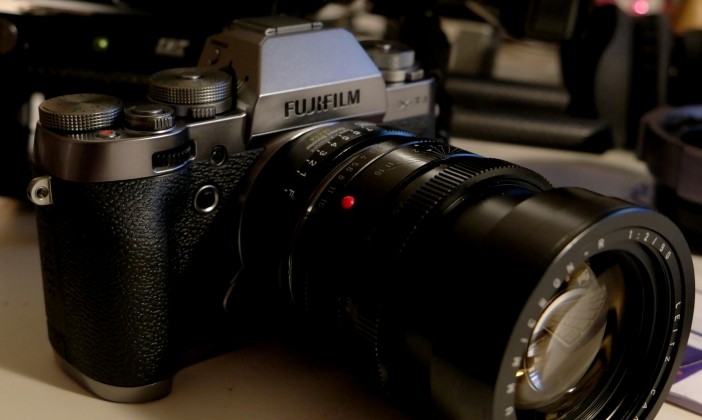
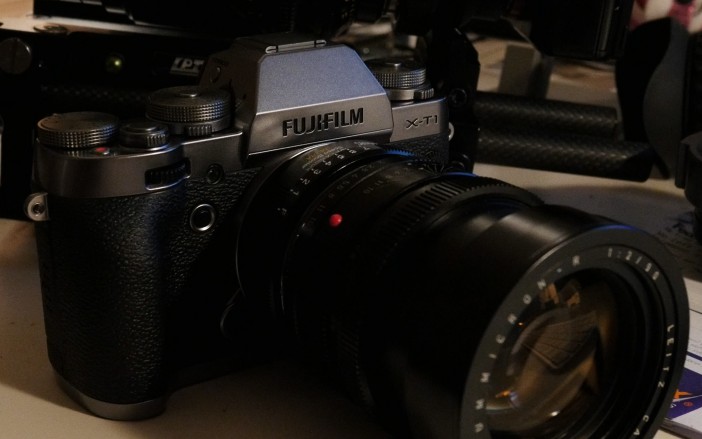
At night if you can get a good exposure, you never need to worry about noise at ISO 800. Even ISO 1600 is OK for most shots as long as you get a decent exposure. ISO 3200 falls off a cliff most of the time. This is no A7S.
To be honest I am not sure where to place the blame for the poor ISO 3200 performance. Clearly the sensor itself is getting noisy at this level looking at the raw stills, but not overly so given the megapixel count approaching that of the D810! So it’s not really the sensor’s fault…the main problem is the blotchiness. It seems either the codec is making things mushy, by over-compressing and clipping the shadows or that aggressive noise reduction is kicking in despite being turned off in the menus. It could even be that noise reduction is applied aggressively in the debayer, before it even reaches the encoder or uncompressed HDMI port. For whatever reason the camera does not have a fine noise structure like the GH4 or C300.
Compared to the Sony A7S, the NX1 is definitely not in the same league for low light but then what is? Neither are Sony’s own $20,000 cinema cameras! A lot of people think that if a camera can’t shoot clean ISO 12,800 then it cannot be used for night shoots. Actually that’s not the case. On the city streets at night for example, the NX1 at ISO 1600 with a fast lens will look great. Some shots are pulled off better than others… The Sony A7S is obviously going to be better in this regard but it is only 1080p internally. The NX1 is cleaner than the GH4 but seems to have more noise reduction going on. Over finely detailed areas of the image this noise reduction leaves plenty of detail intact and plenty of rich colour saturation. This isn’t the case with the GH4 at ISO 1600 even if NR is applied in post.
Even in good light the GH4 has a more grainy, scratchy feel compared to the NX1. This isn’t necessarily worse but it is what I’d consider a massive ‘film stock’ difference.
In terms of pixel pitch the GH4 has 3.7 µm size pixels vs the NX1’s 3.6 µm, so very similar. However I feel the micro lens design, readout circuitry and other aspects of the sensor give the NX1 the edge in low light. What’s more, the GH4 reads 4K from a 1:1 crop of the sensor whilst the NX1 samples 4K from the entire sensor at 6.5K (around 23MP in 16:9) so the downsampling further reduces noise.
The Sony A7S has 8.7 µm pixels so out of reach for now.
Stills wise, ISO 3200 from the raw files is perfectly usable…
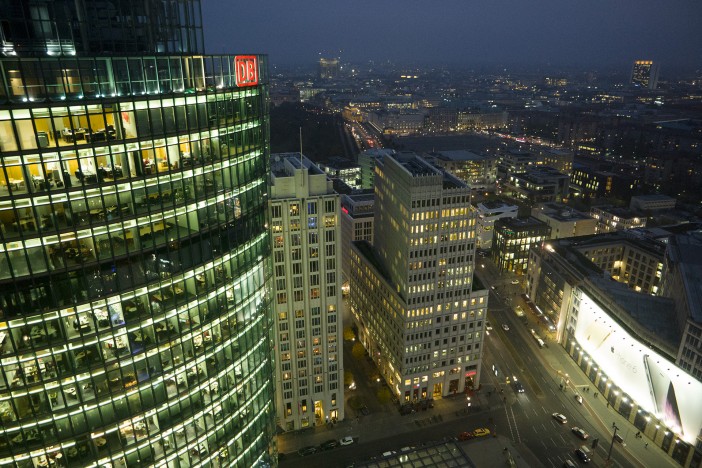
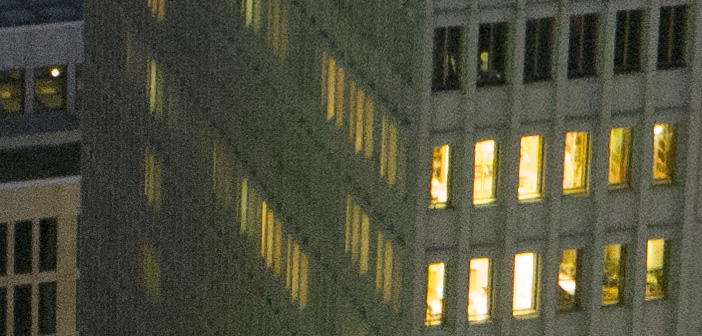
And ISO 800 is lovely and clean…
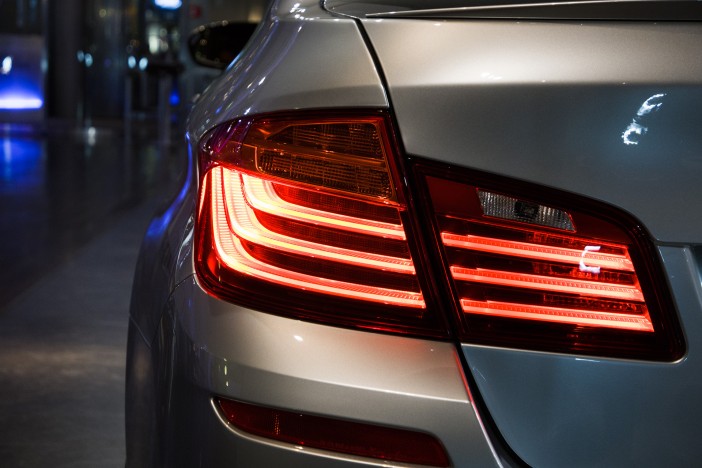
Shoot
Download one of my original NX1 4K clips here (studio scene at ISO 200). This is H.265 converted to ProRes LT.
I shot today in pretty terrible light. Grey sky, grey streets, grey everything. I had about 2 hours of this ‘so called light’ in Berlin, then it went dark. This is why I want to move to Spain! On the NX1, a cheap and cheerful kit zoom and that’s it. Today I got a passive Canon adapter and that allows me to adapt a lot of other stuff, but most of the footage you see here was shot at F5.6 in murky conditions.
Given the poor light today, the footage actually came out pretty well. Motion cadence looks extremely cinematic in 24p at 1/50. It somehow looks organic. I don’t know if this is because of the new codec. It might be. But essentially, motion blur looks like motion blur and not a blocky mess. Buttery smooth. This was NOT the case on my first transcode with Handbrake to H.264. Only with the better transcode to ProRes in Wondershare did I have this lovely filmic motion blur that actually looks like how a 180 degree shutter should.
Colour seems to haven no obvious problems, it is richly saturated without being over-cooked or digital looking.
The sensor in the NX1 I think is impressive but I still think 28MP is too much. I’d love for Samsung to make a low light version of this sensor. However the 6.5K sensor output is scaled beautifully to 4K without any moire or aliasing problems. The same can’t be said for the slow-mo 1080p or internal 1080p modes, but this camera is all about shooting in 4K where the sensor is off the leash. It’s also about taking those 4K files and producing lovely 1080p in Premiere with them.
The camera is PAL / NTSC switchable and also does a clean uncompressed 4K HDMI output. You can set it to the cinema standard of 4096 x 2160 24p as well as the TV standard of Ultra HD. This will be very interesting with the Atomos Shogun and should help the camera a lot in the shadows and at high ISOs.
The HDMI is 4:2:2 but still 8bit. So no 10bit like on the GH4.
Stills wise… let’s just say 28MP is a LOT of resolution to play with. Here’s a 1:1 crop from a full photo… (please excuse the soft lens and poor light!)
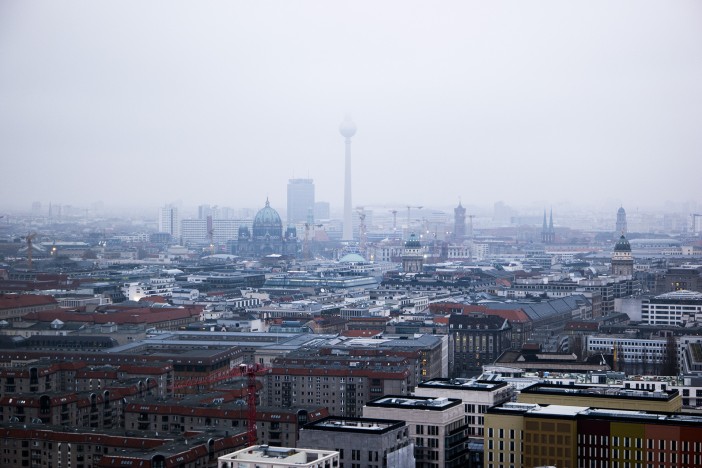

EVF
Again from Jay Kelbley – “The display refreshes at about 54 fps, but the key thing is that the EVF and the sensor are sychronized. The two are genlocked, so there’s always just a 5 ms lag between what’s hitting the sensor and what’s being displayed on the EVF’s current scan line. I think we’re the only ones who can do this.”
The EVF on the NX1 is impressive, far better than what Canon offer on their dedicated Cinema EOS cameras.
The optics aren’t as good as the Fuji X-T1, with more distortion and it feels more cramped due to a lower magnification, but it’s similar to the A7S and GH4 EVFs and counts as high end enough in my book.
The panel on the other-hand is really nice… inky blacks and super high resolution at 2.3MP.
Technology is one thing…
The main issue Samsung have at the moment is a lot of amazing technology waiting to find a purpose.
When you read the comments at Imaging Resource from Samsung’s Jay Kelbley saying they couldn’t recognise an application for the 6.5k at 240fps you have to wonder why they invented it in the first place.
Technology marches on… unless you are Canon! But what Canon do well is to recognise a need and then cater for it. Samsung recognise a technology (like curved OLED panels) then put it out there sometimes without there being a real desire amongst customers for it.
However the world would be a very dull place without them and I do think all this technology is leading somewhere.
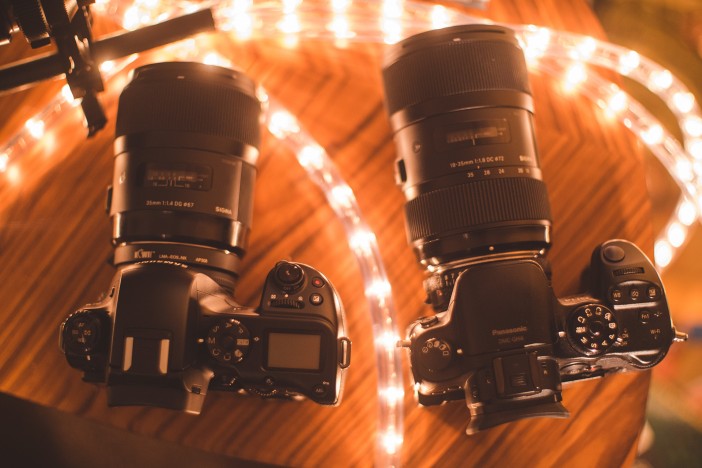
Conclusion
The NX1 is the first Samsung I have ever wanted to keep. Serious photographic dealers have so far avoided them as have serious photographers. However for filmmakers especially, the NX1 is appealing. The 4K image it offers for $1599 is astonishingly good and in many ways better than the Panasonic GH4.
It’s a very serious camera for Samsung, but their job isn’t quite finished. The NX1 lacks the kind of filmmaker feedback clearly present in the GH4 and the broad range of codecs as well as advanced settings like master pedestal and luma-range (0-255). The GH4 will soon get V-LOG (Panasonic’s answer to S-LOG 2 on the Sony A7S) and I hope that Samsung consider a similar firmware update for the NX1.
If you only shoot with ONE camera and you need a full frame sensor along with astounding low light performance clearly the Sony A7S is still the way to go. But the NX1 arguably packs in the most advanced technology. Having an internal 4K codec in the NX1 sets it apart from the A7S in another way.
What of the choice between this and the Panasonic GH4? If you’re already a GH4 owner with Speed Booster and an investment in lenses, I’d be tempted to stick with it. However if you prefer the colour science of the NX1 and the look it delivers overall, plus you want an actual Super 35mm sensor with 1.5x crop rather than the 1.7x crop you get on the GH4 in 4K with Speed Booster, then the NX1 should be seriously considered.
Pros
- Stunning 4K video quality at ISO 200-800
- Super 35mm / APS-C size sensor
- Usable ISO 1600 despite crowded 28MP sensor
- 3200 usable for raw stills
- Superb build quality
- Very nice to handle, excellent ergonomics
- Unfussy controls and sensible menus / screen layout
- Very high quality AMOLED LCD and EVF
- Superbly implemented peaking, responsive and detailed
- Clean 4K HDMI output for uncompressed quality is 4096 x 2160 (Atomos Shogun)
- DCI 4K and Ultra HD like the GH4
- Good colour out of the box on default picture profile setting
- H.265 saves space on card and when master files are archived
- Super 35mm sensor size (APS-C) perfect match to cinema lenses (and the look)
- Superb stills, very high resolution (see here vs D750 and A7S)
- Good dynamic range in both 4K video and stills
- 1080/120fps slow-mo quality is improvement over GH4’s 96fps
- Very advanced AF tracking system
- Lightning fast AF for stills in good light with certain NX lenses
- Extremely fast 15fps continuous shooting rates at 28MP
- Large battery capacity
- Attractive styling, fits well with Sigma ART lenses
- Mount can take Canon and Nikon lenses (though aperture control can be fiddly)
- PAL / NTSC switchable – 4K at 30,25,24p as well as 1080/60/50p
- Very responsive and quick to start and shut down
- Useful top LCD panel
- Well placed video record button
- Manual ISO adjustment can be applied to rear jog wheel for quick exposure changes
- Exposure changes are smooth fading rather than stepped, during recording
- Headphone & mic sockets along with audio meters & mic level control
- OIS generally works well on Samsung 16-50mm power zoom and 16-50mm F2.0-2.8
Cons
- 4K H.265 codec does not maintain a fine noise grain
- H.265 takes time-consuming transcoding step to ProRes, as cannot (yet) be edited natively
- Rather a lot of blocking in low contrast areas and shadows
- ISO 1600 is really the maximum for video (it’s no A7S)
- NX lens mount won’t accomodate a Metabones Speed Booster for full frame look
- Limited customisability of function buttons
- No LOG picture profile for maximum dynamic range and grading flexibility
- Optical distortion in centre of EVF can be distracting
- EVF smaller optically than Fuji X-T1 (but very high resolution)
- No adapter for electronic aperture control of Canon EF lenses yet
- Rolling shutter in 4K still can be an issue (but it’s too bad given the 28MP full pixel readout!!)
Glorious technology applied well on the most part, the NX1 is one of the best 4K cameras in good light and it costs just $1599. It is not the low light performer the Sony A7S is of course - or even the Nikon D750 - but it does hold its own against the GH4.
The extra transcoding step for H.265, lack of LOG picture profile and yet another different lens mount might turn some away, but the Super 35mm sensor means you do not need to add a Speed Booster like on the GH4 to get the cinema field of view from your lenses. Very high resolution stills compared to the competition, at 28MP and very high continuous burst rate at full resolution in raw at 15fps.
-
Resolution
-
Dynamic range
-
Colour
-
Rolling shutter
-
Slow-mo
-
Build quality
-
Ergonomics
-
Screen and viewfinder
-
Codec
-
Low light



